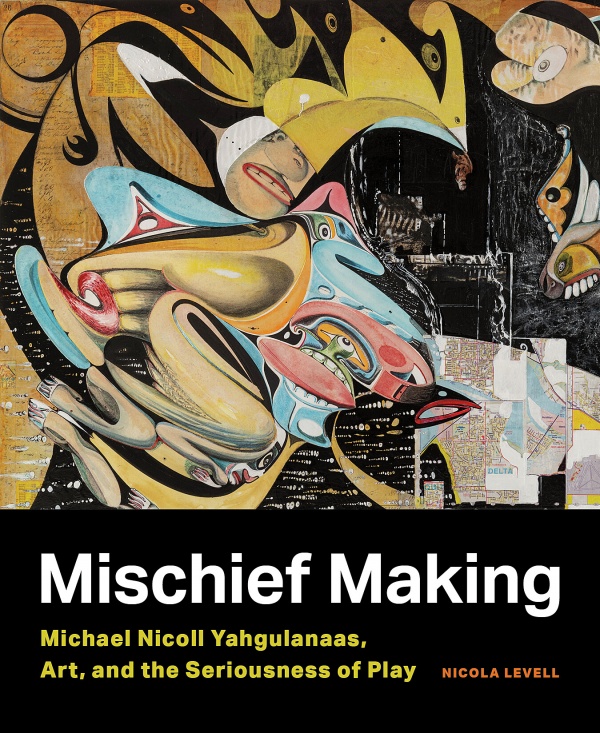Haida Manga and the Art of Michael Nicoll Yahgulanaas
Posted: Wednesday, October 13, 2021
DECEMBER 4: Join MOA, Figure 1 Publishing and UBC Press to celebrate the launch of two new publications on art, performance and play—Mischief Making: Michael Nicoll Yahgulanaas, Art, and the Seriousness of Play and Bodies of Enchantment: Puppets from Asia, Europe, Africa and the Americas. Learn more.
In a gorgeously illustrated exploration of the art of Michael Nicoll Yahgulanaas, Mischief Making: Michael Nicoll Yahgulanaas, Art, and the Seriousness of Play demonstrates how playful and punning gestures can shed light on serious subjects.
In the below excerpt, author Nicola Levell introduces the reader to Haida manga and the unique character of Michael Nicoll Yahgulanaas' art.
The idea of putting unconventional character types, ideas and media “in play” as means to expose, stretch and subvert our cultural perceptions is intrinsic to the art of Michael Nicoll Yahgulanaas. On the surface of his works, he signs himself ‘mny’ with a fish-like flourish. His name has become synonymous with Haida manga, an artform he innovated that reformulates and blends Indigenous Northwest Coast iconographies and formlines with the graphic dynamism of Japanese manga. Through this creative mix or creolization, Haida manga has emerged as a vibrant visual idiom for retelling Indigenous oral histories and other narratives and for offering different ways of seeing and knowing cultural complexes. Its expressive imagery often engages with contemporary social issues concerning the environment and interdependent ecologies, Indigenous thought-worlds and global anxieties, and the materialities of cultural heritage and memory. Yet Yahgulanaas’ distinctive Haida manga aesthetic is not restricted to publications and paper-based graphic artworks: it has modulated into a diverse but coherent body of media and forms, including large-scale public art projects forged from steel; repurposed automobile parts covered in metallic leaf; mixed media installations; acrylic and oil painted canvases and boards; watercolours, ink drawings, ceramics and animated forms.
Part of the unique character of this elastic genre is its unfinching commitment to, in Yahgulanaas’ words, “hybridity”. In his case, hybridity is envisaged as a positive force that opens a space—in Homi Bhabha’s postcolonial thinking this is a “third space”—for artistic and public engagement with the politics and poetics of being in the world.[2] For Yahgulanaas, this means being recognized as an artist of Indigenous Haida and European ancestry, with multiple connections to and affnities with other cultures and places.[3] Yahgulanaas is serious about the potential of hybridity, as an identifcation, aesthetic and strategy, to elicit reaction and challenge established hierarchies, attitudes and stereotypes. Art is mobilized as a form of social empowerment: it seeks participation, dialogue, refection and action.
Even the naming of his practice—the purposeful melding of Haida and manga—can be understood as a political act of hybridization that indexes the creation of a third autonomous form, a new art for negotiating new perspectives, positions and identities. By strategically aligning with manga and more generally Asia-Pacifc cultural practices, Yahgulanaas consciously set out to subvert dominant Western aesthetic forms and simultaneously signal his cultural and personal familiarity with cultures of the Pacifc Rim and especially Japan, which has long featured in Haida oral histories and Yahgulanaas’ family memories. He explains, “I was drawn to comics as a way of talking about complex things such as relationships between Indigenous peoples and settler society. I found manga attractive because it is not part of the settler tradition of North America (like Archie or Marvel comics, for example) ... [plus it] has roots in the North Pacifc, as does Haida art”.[4] While his art always has had a political infection, it is neither prescriptive nor bound to the local or Indigenous context. Rather it presents itself as an agitation for individual and social engagement:
Artwork is a personal adventure for the people who create it and for those who choose to participate in the experience. I create work that mostly avoids the idea of dominance and resists the idea that the artist is an ultimate authority ... I like to create work that confounds the observer and requires them to decide where the dominant horizon of the work is. [In the Rotational series] I put my name in one corner, a title in another, a date in a third corner, and I usually fnd something amusing to put in the fourth ... I encourage people to make observations and choices arising from their own experience without relying on the authority of the artist.[5]
These strategies of captivating the viewers’ attention, luring them into the artwork, making them think about the characters and the lines, making them twist their heads, literally and metaphorically, to fathom out relations and meanings, are manifest in Master Chief, 2020. This complexly textured work is part of a series of collages that includes Gunit, 2020, Milkit, 2020, Hooked, 2020 and Sinking into the Ocean, 2020—a detail of which is reproduced on the front cover of this book.
Read more in Mischief Making: Michael Nicoll Yahgulanaas, Art, and the Seriousness of Play by Nicola Levell.
[2] Bhabha, Homi, The Location of Culture, London and New York: Routledge, (1994) 2004, pp 53–54.
[3] Michael Nicoll Yahgulanaas, personal communication, 13 October 2014.
[4] Yahgulanaas, Michael Nicoll, “RE ME MB ER: The Hybrid Art of Michael Nicoll Yahgulanaas”, GEIST
Magazine, no 70, 2008, p 54.
[5] Sostar McLellan, Kristine, “Mythic Proportions: A Haida Artist Weaves Cultural Traditions into Something

